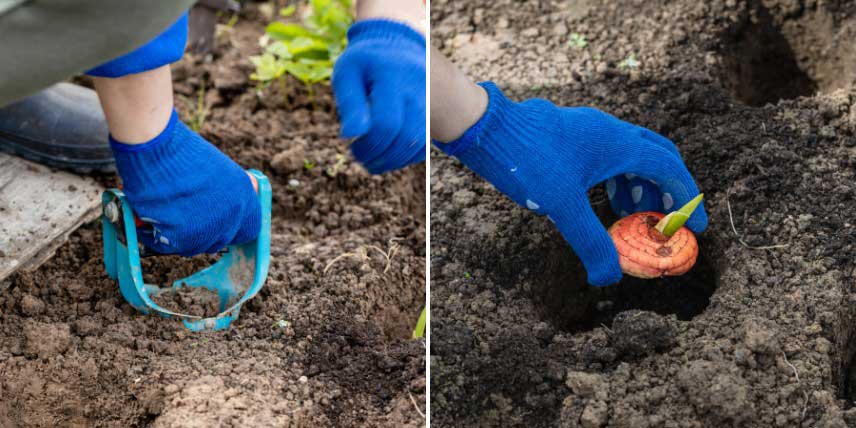
Planting summer flowering bulbs
Discover where, when, and how to plant them!
Contents
Summer bulbs are invaluable in the garden for adding a beautiful splash of colour to borders or pots! Whether it’s dahlias, gladioli, lilies, or cannas, their flowering is a true spectacle! These bulbs ensure a blooming garden for a very long period, throughout the summer season. To achieve this, it is important to succeed in their planting: discover all our tips on how to plant them, in pots or in the ground!
Where to plant summer bulbs?
Plant them in rich, well-drained soil as stagnant moisture encourages bulb rot, in a sunny and sheltered position from the winds. Feel free to plant them in groups of at least 5 to 7 bulbs for a more beautiful effect!

When to plant summer bulbs?
Plant sensitive bulbs preferably in pots. In open ground, wait until the end of severe frosts between late April and mid-May, depending on the regions, before planting. You can also speed up their cycle by planting them as early as February in pots under cover and frost-free, to transplant them into the garden when the weather improves (around June in the North of France). For more information, feel free to consult our article: Preparing summer bulbs
How to plant summer flowering bulbs?
The planting of summer bulbs, whether in pots or in the ground, is quite simple.
How to plant them in pots?
For pot cultivation, choose compact and dwarf varieties preferably and consider installing a stake if needed, right from planting to avoid damaging the bulb(s) later on.
- The choice of pot varies depending on the type of bulbs, but choose a pot with a diameter of at least 40 cm. Dahlias grow quite large, so count on one dahlia per pot (which you can combine with other summer-flowering bulbs depending on the vigour of the Dahlia). It is also possible to plant 3 dahlias in a large container like a half wooden barrel.
- Ensure that the bottom of the pot is well-drained;
- Place a layer of clay balls or gravel;
- Lay a piece of felt to isolate the drainage layer from the potting soil that could seep through and block the pot’s holes;
- Make a light mix of good garden soil and potting soil, at a ratio of 25-75 or 100% potting soil if you do not have a garden. Add a bit of river sand if needed to perfect the drainage;
- Fill your pot with substrate;
- Arrange the bulbs in a staggered pattern and plant them at a depth of 2 to 3 times the height of the bulb;
- Water so that the substrate never dries out completely, but do not drown it with every watering;
- Provide a special bulb fertiliser, not too rich in nitrogen which would encourage foliage growth at the expense of flowering.

How to plant them in the ground?
- Start by properly loosening the soil using a hoe, a fork or a broadfork for example;
- Plant your bulbs respecting the depth according to their calibre, counting on average two to three times the diameter of the bulb. Make a hole with a bulb planter or a transplanter;
- Place your bulb and cover it with 5 to 10 cm of soil depending on the varieties, keeping sufficient spacing according to their adult development;
- Make an application of organic fertiliser at planting;
- Water regularly so that the soil never dries out completely.

And after?
Remember to remove faded flowers as they occur. Allow the foliage to yellow to regenerate the bulbs and ensure flowering the following year. In autumn, bulbs planted in the ground should be dug up before the first frosts and kept cool and dry, while those planted in pots should also be stored.
Pascal’s tips: In pots, you can plant summer bulbs in lasagne. For this, check out our tutorial on planting bulbs in lasagne. Finally, feel free to plant in groups for a beautiful effect in the garden!
- Subscribe!
- Contents































